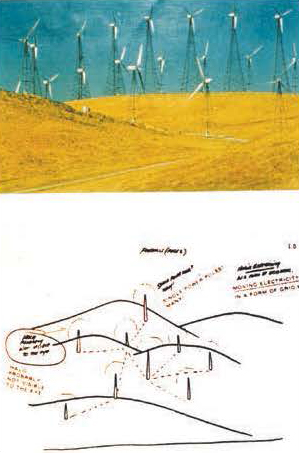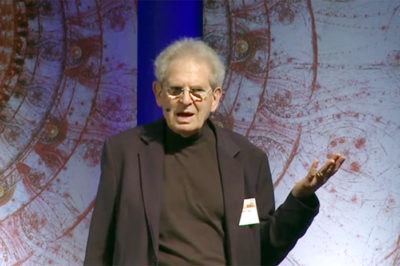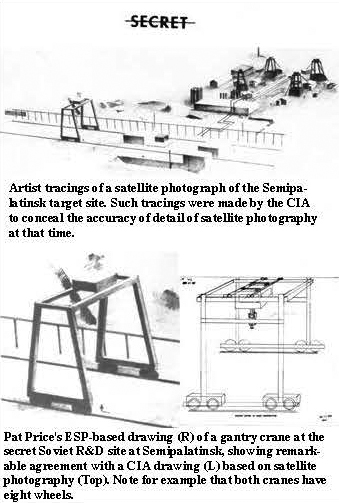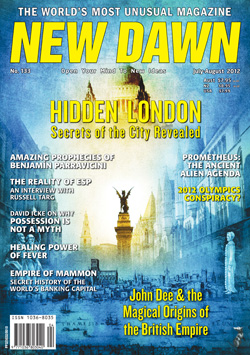From New Dawn 133 (Jul-Aug 2012)
Russell Targ is perhaps the best-known psychic investigator of our times, and certainly among the most academically prestigious. Born 11 April 1934 in Chicago, USA, he received a Bachelor of Science in physics from Queens College twenty years later, and did graduate work in physics at Columbia University (both in New York). He retired in 1997 as a project manager and senior staff scientist from Lockheed Martin, an American aerospace and advanced technology company, where he developed laser technology for airborne detection of wind shear and air turbulence. Wind shear, a difference in wind speed and direction over a relatively short distance in the atmosphere, is a potential aeronautical hazard. Targ’s inventions and contributions in lasers and laser communications won him two National Aeronautics and Space Administration awards.
Beginning in the 1970s, he co-founded a twenty three-year program of research into psychic abilities and their operational use for the US intelligence community. Until 1995, it was classified “secret.”
His autobiography, Do You See What I See: Memoirs of a Blind Biker, tells of his life as a scientist and legally blind motorcyclist. The publishing arm of The Theosophical Society in the United States – Quest Books – recently released his latest book, The Reality of ESP: A Physicist’s Proof of Psychic Abilities.
According to reviewer Eugene Bourgeois, “Russell Targ looks at the subject from the perspective of an experimental physicist and finds compelling scientific evidence to confirm that something very much like ESP can be demonstrated without fail under laboratory conditions. As any physicist would, he seeks to find a model that will help us describe just how it is that such experiences are possible.”
In this pointed interview for New Dawn magazine, Targ offers his latest conclusions about the relationship between the demands of hard science and the paranormal potential of inner human experience.
FRANK JOSEPH (FJ): Your work as a physicist in the early development of lasers and research into meteorological anomalies forms an unusual backdrop to the unrelated, unconventional field of psychic investigation. What caused your radical departure from mainstream science?
RUSSELL TARG (RT): I had a childhood interest in magic and card tricks. I performed on the stage as a magician, as a teenager. In the course of doing mental magic on stage, I had numerous psychic experiences, leading me to get more interested in real magic than stage magic. At that point, as a young scientist, physics graduate student at Columbia, I began to read the professional parapsychology literature.
FJ: What was your own, most significant psychic experience?
RT: My own most significant public remote viewing experience was my very accurate description and drawing of my colleague Hal Puthoff’s location at an island airport off the coast of Columbia two thousand miles away. I have also had very powerful out-of-body experiences of a more personal nature.
FJ: What, if anything, did Robert Monroe, the mid-20th century American New York radio-broadcasting executive who achieved worldwide recognition as an explorer of human consciousness, contribute to your understanding of psychic phenomena?
RT: I knew Bob Monroe well. He brought the idea of out-of-body (OOB) experience to common usage. He helped us understand that there is a continuum from simple remote viewing, where one sees images on ones mental screen, to OOB experiences where one can bring emotional and sexual sensitivity to the fore. No one ever had a bad remote viewing experience. But one can indeed scare himself with a bad OOB trip – because of the increased emotional involvement. Aleister Crowley describes this as “sex on the astral plane.” Not for the timid. And we did not pursue this at SRI [Stanford Research Institute].
FJ: Your latest book is supposed to distil your lifetime of paranormal research and latest conclusions. Can you give us a summary of The Reality of ESP?
RT: It provides statistical proof of psychic phenomena as evidence so strong it would be logically or probabilistically unreasonable to deny. If facts alone can convince a skeptical investigator of the reality of ESP, this book should do it. It presents evidence from the research program I co-founded at Stanford Research Institute (SRI) in the 1970s, together with the Buddhist and Hindu origins of ESP. Some of the amazing feats of psychic ability include remote viewing for America’s Central Intelligence Agency and US Army Intelligence, when SRI psychics found a downed Russian bomber in Africa, reported on the health of American hostages in Iran, described Soviet weapons factories in Siberia, and forecasted a Chinese atomic-bomb test three days before it occurred.
When San Francisco heiress Patricia Hearst was abducted from her home in Berkeley, a psychic with the SRI team was the first to identify the kidnapper and then accurately described and located the kidnap car.
After leaving SRI, our group made $120,000 by psychically forecasting for nine weeks in a row the direction and amount of changes in the silver commodity futures market, without error. The odds against chance in many cases are staggering. Take the thirty-six outdoor remote viewing trials described with six US Army intelligence officers. Their overall statistical significance was at odds of three in a hundred thousand (3 x 10-5). If the officers had been baseball players, the expected six first-place matches would equal a batting average of one hundred sixty six. But they achieved nineteen matches – batting better than five hundred – while the great Joe DiMaggio had a lifetime average of only three hundred thirty five. Such numbers are what we mean by statistical proof.
We achieved an effect size of 0.6, which is ten times greater than that claimed by America’s National Institute of Health for aspirin preventing heart attacks. I am convinced that most of us have psychic abilities we haven’t tapped, and conclude my book by describing how we can learn to develop our own ESP, at no cost, working at home using the SRI techniques with a friend. It involves a simple, meditative skill that eighth-century Buddhists called moving from conditioned to spacious or naked awareness. Who would not want to try that?
FJ: In The Reality of ESP, you cite four kinds of psychic experiments, beginning with remote viewing, in which a person describes places and events independent of space and time. Professor Richard Wiseman, a British psychologist at the University of Hertfordshire, told the Daily Mail four years ago, “Because remote viewing is such an outlandish claim that will revolutionise the world, we need overwhelming evidence before we draw any conclusions. Right now we don’t have that evidence.” How do you respond to his conclusion?
RT: We published our formal experiments in the Proceedings of the Institute of Electronic and Electrical Engineers, and in Nature. In our first decade of work at Stanford Research Institute we did three highly significant experimental series. These comprised trials wherein a person in a shielded room with me had to describe what it looked like where my colleague Hal Puthoff and another witness were hiding in the San Francisco Bay area. In the first series of nine trials, a psychic policeman, Pat Price, achieved seven first place matches, where only one would be expected by chance.
The probability of this is less than one in a hundred thousand. In the second series, a “control” subject photographer Hella Hammid, got five first place matches and four second place matches. The probability of this is approximately one in a million. In the third series, we taught six army intelligence officers how to do remote viewing, as part of the government’s program to set up an army psychic corps in Fort Meade, Maryland (USA). The six men each did six trials. Out of those thirty six trials, they got nineteen first place matches, where six would be expected by chance, again at odds of one in a hundred thousand. Our work had been replicated at Princeton and dozens of other labs worldwide.
FJ: Can remote viewing be illustrated by the concept, in physics, of photon entanglement? If so, how do you define photon entanglement in relationship to psychic activity?
RT: Photon entanglement is a consequence of space-time non-locality, wherein two photons that are created together (twin photons) travel on opposite directions at the speed of light, and the measurement on one affects the other. This non-locality, I believe, is the basis of ESP. Since remote viewing accuracy and reliability are independent of distance and time (up to a few days into the future) a physicist would say that the data for remote viewing appear to be non-local.
FJ: During the Cold War, the US Government’s Central Intelligence Agency undertook a serious study of remote viewing, eventually terminating its $20 million dollar “Stargate Project” after David Goslin, of the American Institute for Research, declared, “There’s no documented evidence it had any value to the intelligence community.” Was he right after all?
RT: The CIA, the Defense Intelligence Agency, and Army Intelligence Command would not have supported our program for twenty-three years and $25 million if we had not produced useful information. The program was secret. We successfully described Soviet submarines, a kidnapped US general in Italy, etc. That’s why they kept supporting us.
FJ: According to psychologist David Marks, remote viewers are influenced by subjective validation, a process through which correspondences are perceived between stimuli that are in fact associated purely randomly. Couldn’t this be a real explanation for remote viewing?

RT: The first published remote viewing experiment had some clues as to the order of some of the trials. These clues were removed, and the series was re-judged with exactly the same outstanding results. All other series were doubly randomised to remove this valid criticism. Transcript clues wouldn’t help us find the kidnapped US general or the downed Russian plane.
FJ: Your book also discusses possibilities for distant mental influence, where the thoughts of the experimenter can positively or negatively affect the physiology – including heart rate or skin resistance – of someone far away. Can you cite any credible examples of this phenomenon?
RT: William Braud wrote a book called Distant Mental Influence which presents twelve of his experiments showing that the thoughts of one person can affect the physiology of another person. This is also the basis of distant healing. My book describes my daughter psychiatrist Elisabeth Targ’s published experiment showing that the half of her AIDS patients who received distant prayer had significantly better health outcomes than the thirty controls. This paper was published in the Western Medical Journal in 1999.
FJ: Our readers may be less familiar with Whole Field Isolation mentioned in The Reality of ESP. As I understand it, WFI applies to a “viewer” who accurately describes the visual experiences of someone else in another place. Does the “viewer” actually enter into the mind of another person, and how is this process achieved?
RT: The person who is isolated in the “Ganzfeld” isolation chamber can obtain information seen by his/her distant friend either clairvoyantly or by telepathy – no way to tell.
FJ: What exactly is the “Ganzfeld isolation chamber,” and how does it have any bearing on remote viewing?
RT: The Ganzfeld isolation chamber has the purpose of removing all physical stimulation from a person’s awareness. The perceiver in the Ganzfeld is isolated from all electromagnetic radiation. He has white noise fed into his earphones, together with red light shown onto Ping-Pong ball halves fitted over his eyes. This isolation is thought to be a psi-conducive state, suited to daydreams and free association. Very good ESP results have been obtained with people in the Ganzfeld chamber. But not any better than a remote viewer sitting at a table in the lab.
FJ: You write of Retrocausality, in which future events can allegedly affect history. But the future has not happened yet, so how can it influence the past?
RT: When you have a dream on Sunday night of an elephant walking down your street and trampling your flowers, and then see the elephant doing exactly that the next morning, we would say that Monday morning’s experience of the elephant was the cause of Sunday night’s dream. That’s what we mean by retrocausality. In a non-local world, your consciousness is not separated from the future.
FJ: Oral traditions from Tibet and Polynesia tell of large groups of persons who together entered into altered states of consciousness, then simultaneously focused all their individual thoughts on a single, common objective – i.e., to cure or kill someone, levitate a stone weighing several tons, etc. Were these credible examples of distant mental influence? If so, what do they say of possibilities for similar psycho-communal efforts undertaken today?
RT: As a physicist, I am not involved with the claims of oral traditions. However, I am impressed with Buddhist and Hindu books describing techniques for remote viewing dating from the time of Christ, wherein the instruction are very similar to what we do in the lab.
FJ: Exactly how does ESP work based on the Buddhist/Hindu view of our selves as non-local, eternal consciousness?
RT: The Buddhists and Hindus didn’t know how ESP works, anymore than we do today. But they did believe that separation is an illusion; that our awareness transcends all of space and time. They taught that we can see into the distance and into the future; heal the sick and diagnosis illness – all psychically. The metaphor of Indra’s net describes a world in which every vertex of the net is a highly polished jewel, which reflects all others in the net. This is an early holographic model that is very suggestive of the non-local description we use today.
FJ: Do you believe that psychic abilities are either inherited from a period earlier in our past, when they were more highly developed than today, but have since languished? Or do they represent a new development in human evolution?
RT: I believe that psychic abilities are an evolutionary progressive ability. They helped the caveman become aware that a tiger was at the door of his cave, etc. They are definitely not new in any sense. Buddhists and Hindus described them exactly as we know them today.
FJ: Archaeologists discovered that, some twelve centuries ago, Maya priests were ingesting 5-MeO-DMT, a psycho-active chemical excreted from the poison gland of Bufo alvarius, a local toad, because it engendered the “flight of the shaman” beyond space and time. The Bufo toad is depicted at the Mexican shrine of Izapa, where the 2012 Mayan calendar end date was inscribed. Could the Maya have thereby projected their consciousness into our time, then returned to theirs, where they composed their “prophecy”?
RT: There is no convincing data showing that DMT or anything else will make you psychic. Too bad! It only makes you feel psychic.
FJ: In Dogs That Know When Their Owners Are Coming Home, British biochemist Rupert Sheldrake describes what appears to be a telepathic bond between pet animals and their human owners. Do you believe his research is valid? And if so, can you suggest any method to strengthen or expand that bond to some degree of trans-species communication?
RT: I am confident of trans-species communication. Any cat owner knows that all you have to do is think of taking your pet to the vet, or giving her a bath, to have the cat immediately disappear.
FJ: What, if anything, has ESP got to do with questions concerning the survival of human consciousness after physical death? What might ESP teach us about the alleged immortality of the human soul?
RT: If one believes that who we are is “non-local and timeless awareness,” then the idea that this awareness is eternal, is quite natural. Our awareness, whether alive of dead, is outside space and time. I believe that the evidence for survival of consciousness and personality is quite good.
FJ: Parapsychologists argue that the greater development of remote viewing could lead to either the end of war or more deadly military applications. What is your opinion?
RT: Remote viewing is definitely useful in wartime, since it provides intelligence information, which is frequently unavailable any other way. Human beings love to be at war. ESP is not going to end that. But it might encourage people to be more honest with one another, if they are aware that lies will be immediately detected.
FJ: Larry Dossey, M.D., author of The Power of Premonitions, states that “the mind can function without limitation in space and time, and that this ability is widespread, teachable, and practical.” Should teaching psychic development become part of public education? If so, how might this be achieved?
RT: I think it would be very important to encourage children to develop their psychic abilities – it is part of who they are. I taught my own children to be polite, intelligent and psychic as they were growing up. And it didn’t seem to hurt any of them (two doctors and a lawyer). Like many things, I think psychic abilities are better taught at home, rather than at school. But since it is an ability we all have naturally, it is very desirable that children be made aware of this gift before it is stifled and repressed by the larger society.
FJ: What advice would you give anyone just beginning to explore their psychic potential?
RT: I would suggest that a beginning remote viewer should find a partner to work with. The partner can bring you little objects in a bag, and encourage you to psychically describe them. You can then do the same for your partner. This is a surprisingly easy and enjoyable activity.
FJ: Do you foresee a time when humanity in general will have developed its entire psychic potential, as described in your new book? If so, what kind of a world will that be?
RT: I believe humanity will indeed make use of their psychic potential, with the result that people will quit lying to each other. They will also begin to notice that there is more to life than flesh and bones. That is, we have the capacity for timeless awareness, which, in fact, is what we are.
The Reality of ESP: A Physicist’s Proof of Psychic Abilities (Quest Books, 2012) is available from all good bookstores and online retailers.
© New Dawn Magazine and the respective author.
For our reproduction notice, click here.




